History of Kramatorsk
Origin of Kramatorsk
According to archaeological research, people began to settle on the territory of present-day Kramatorsk and its suburbs in ancient times. On the northwestern outskirts of Kramatorsk, quarries and workshops for processing flint of the Neolithic era were found. In the suburbs of Kramatorsk, a burial mound of a metallurgist-caster of the Bronze Age was also discovered.
In the second half of the 18th century, the territory of today’s Kramatorsk was settled by the Cossacks of the Sloboda Cossack regiments (abolished in 1765). In 1799, the territory of the future Kramatorsk was included in the Izyum district of the Sloboda-Ukrainian (later renamed Kharkov) Governorate.
In 1868, during the construction of the Kursk-Kharkov-Azov railway, a railway siding called Kramatorovka was built near the Kazenyi Torets River. In 1875, the name Kramatorovka was mentioned for the first time in the Post Road Book of the Russian Empire. In the “Guide on the Kursk-Kharkov-Sevastopol Railway” published in 1902, it is explained that Kramatorovka is the erroneous name of Krasnotorovka, named in turn after the Krasny Torets River.
In 1878, at the initiative of Savva Mamontov, a branch of the Donetsk Coal Railway was joined to Kramatorovka. It turned into a full-fledged nodal freight and passenger railway station. In 1879, the construction of a stone station building began. In 1880, the first two-story apartment building for railroad workers was constructed. In 1899, the management of the Southern Railways opened a school for the children of station employees, post, telegraph, and police officials here.
More Historical Facts…
In 1896, an important event happened that determined the future of Kramatorsk. It was then that the Swiss Konrad Gamper took Russian citizenship, bought a land plot near the Kramatorovka station, and his company started construction of a machine-building plant. Today, it is known as Starokramatorsk Machine-Building Plant.
In 1899, Konrad Gamper founded the Kramatorsk Metallurgical Society, and in the same year the first blast furnace was put into operation at the Kramatorsk metallurgical plant. Today, the name of Konrad Gamper - the founder of the machine-building and metallurgical plants of Kramatorsk - occupies a worthy place in the history of industrial development of Ukraine.
Kramatorsk in the first half of the 20th century
At the beginning of the 20th century, other industrial enterprises were opened in Kramatorovka and around it. In 1910, in one of the buildings of the plant of the Kramatorsk Metallurgical Society, the movie theater “Era” was opened. The plant began to specialize in the production of equipment for metallurgical plants and coal mines. Steam locomotives were also repaired in its workshops. In 1911, about 160 thousand tons of pig iron and 61 thousand tons of steel were produced here.
In 1912, the cement plant “Pushka” (“cannon”) of the Russian-Belgian society began to operate. Its first products were intended for the construction of the St. Petersburg Arms Plant, hence the name. The population of Kramatorovka was about 12,000 people at that time.
For several months in 1918, during the First World War, Kramatorovka was occupied by German troops. It was part of the Ukrainian State (also known as the Second Hetmanate), which was installed by German military authorities and headed by Pavlo Skoropadskyi. On February 5, 1919, the village became part of Soviet Ukraine as part of the Donetsk Governorate (official secession from the Russian Soviet Federative Socialist Republic on February 17, 1919, the day the Donetsk-Krivoy Rog Republic was abolished).
In 1920, the plant of the Kramatorsk Metallurgical Society was nationalized and received the name of the Kramatorsk State Machine-Building and Metallurgical Plant. In 1923, the Kramatorsk district was created. Kramotorovka became its administrative center. In 1926, the population of Kramatorovka reached the pre-war level of 12,000 people. In 1932, the Kramatorsk district was disbanded and Kramatorovka received the status of a town with the name Kramatorsk as part of the newly formed Donetsk Oblast.
By 1926, the blast-furnace and open-hearth shops of the metallurgical plant surpassed the pre-war level of production. In 1927, the first printed newspaper of the town appeared, called “Kramatorsk Domna”. On September 19, 1930, it was renamed into “Kramatorsk Pravda”. In 1930, the Kramatorsk Machine-Building Institute was established on the basis of the machine-building technical school.
According to the census of 1939, the population of Kramatorsk was 94,114 people (increased by almost 8 times in 13 years). In 1940, more than 30 thousand workers, 5 thousand engineers and technicians worked at the city’s plants; there were 4 hospitals, 33 schools. On February 24, 1941, after four years of construction, the Kramatorsk Heavy Machine Tool Plant was put into operation.
Kramatorsk during and after the Second World War
On October 27, 1941, during the Second World War, German troops occupied Kramatorsk. On February 6, 1943, the Soviet troops managed to drive the Germans out of the city with a counteroffensive. On February 27, 1943, the German army recaptured the city. On September 6, 1943, Kramatorsk was again liberated by Soviet troops.
During the occupation, about 6 thousand locals were killed, more than 10 thousand people were sent to Germany for forced labor. All industrial enterprises were destroyed, as well as about 1,300 houses, 15 schools and a number of other institutions.
In the post-war years, destroyed enterprises were restored in Kramatorsk, more than 10 new industrial facilities were built. The 1950s and 1960s became a period of industrial, economic and cultural development of Kramatorsk. In 1967, the city museum of Kramatorsk was opened. In 1968, Kramatorsk solemnly celebrated its 100th anniversary. From 1956 to 1989, the population of Kramatorsk increased from about 117,000 to 198,000 people.
Radiation Incident in Kramatorsk
In the 1980s, the so-called Radiation Incident in Kramatorsk took place in the city. In the late 1970s, a source of ionizing radiation was lost in the Karansky quarry in Donetsk Oblast - a capsule with cesium-137, which was used in the radioisotope level gauge of an enterprise that produced crushed stone. The capsule was not found.
In 1980, a panel apartment building was commissioned in Kramatorsk on Gvardeytsev-Kantemirovtsev Street (today, it is the building #7 on Mariyi Pryymachenko Street). The lost capsule, which emitted about 1,800 Roentgen per year, along with crushed stone, was immured into one of the walls of this building.
In the summer of 1981, an 18-year-old girl died in one of the apartments of the building, a year later - her 16-year-old brother, then their mother. Another family moved into this apartment, in which a teenage boy died in 1987, and his younger brother became seriously ill. All those who died died of leukemia. Doctors could not establish the cause of the disease and explained a similar diagnosis by hereditary predisposition.
The father of the second family turned to the sanitary and epidemiological station with a request to check the background radiation in the apartment. During the check, dangerous levels of radiation were recorded, especially high in the children’s room, in the adjacent apartment behind the wall and in the apartment on the floor above.
The dwellers of these apartments were relocated. The source of radiation was localized inside the panel of the inter-apartment partition. After cutting out part of the wall, it was taken to the Kyiv Institute for Nuclear Research, where the capsule with cesium-137 was removed. After the source was removed, the level of radiation in the building caught up with the natural background. In total, 6 people died (4 children and 2 adults) and 17 were recognized as victims of radiation exposure and became disabled.
Kramatorsk in independent Ukraine
Since 1991, Kramatorsk has been a city within independent Ukraine. In the early 1990s, the rupture of economic and financial ties with the republics of the former USSR turned into an economic crisis for the city’s enterprises. In 1998-1999 the economic situation stabilized. In the 2000s, the local industry began to grow again. In 2003, the index of industrial production in relation to 1990 was 95.8%.
On September 24, 2008, the flag and the new coat of arms of Kramatorsk were adopted.
In the mid-1990s, the population of Kramatorsk reached a historical maximum of about 203 thousand people. After that, it began to steadily decline and decreased by 27% (56 thousand) by 2021. The residential sector of the city is represented by both one-story private buildings and multi-story (2-5, 9, 14) apartment buildings.
From April 12 to July 5, 2014, Kramatorsk was controlled by the forces of the self-proclaimed Donetsk People’s Republic. During the Anti-Terrorist Operation (ATO) carried out by the Ukrainian authorities against armed militias in Kramatorsk, several dozen people were killed in street battles. On July 5, 2014, after leaving Slavyansk, the DPR forces also left Kramatorsk.
On October 13, 2014, Kramatorsk received the status of the administrative center of Donetsk Oblast, since Donetsk remained under the control of the Donetsk People’s Republic.
On February 10, 2015, the Kramatorsk airport, where the headquarters of the Anti-Terrorist Operation was located, and the city itself were shelled. As a result, 17 people were killed, of which 9 were soldiers of the Armed Forces of Ukraine; 64 people were wounded, including 15 servicemen and 5 children.
On April 8, 2022, during the Russian invasion of Ukraine, a missile attack was launched on the railway station of Kramatorsk. 57 people were killed and 109 were injured.
As of the beginning of 2023, most of the population left Kramatorsk on their own or was evacuated. However, thousands of people still live in the city. In the event of the fall of Bakhmut, Kramatorsk and nearby Slavyansk will become the main and last significant Ukrainian defensive line in Donetsk Oblast. It is quite possible that the outcome of the war will be decided in the battles for these two cities.
Kramatorsk Features
Kramatorsk and the villages adjacent to it lie in the valleys of the Kazenyi Torets River and its tributaries, surrounded by hills. The hills are cut by ravines and gullies. The City Day of Kramatorsk is celebrated on the 4th Sunday of September. According to the 2001 census, 31.06% of the surveyed residents of Kramatorsk said that their native language was Ukrainian, 67.87% - Russian.
The highway of national importance H20 (Slavyansk - Donetsk - Mariupol) passes through Kramatorsk. Public transport of Kramatorsk is represented by buses and trolleybuses. Several tram routes also operated in the city from 1937 to 2017.
The climate of Kramatorsk is moderately continental with relatively cold winters and hot dry summers. The average temperature of the coldest month (January) is minus 4.2 degrees Celsius, the average temperature of the warmest month (July) is plus 21.2 degrees Celsius.
Kramatorsk is considered to be the mechanical engineering center of Donbass. Mechanical engineering is predominantly heavy for the metallurgical, coal, transport, and energy industries. The city has a scientific-research and design-technological institute of mechanical engineering. More than half of the total number of employees in Kramatorsk work in local industrial enterprises.
Interestingly, in Soviet times, the guides always informed the guests of the city that Kramatorsk was a city of five sunrises a day. This was due to the fact that from the blast furnaces of the metallurgical plant, several times a day, liquid hot slag was taken out and poured onto dumps, which in the dark looked like a red glow, similar to the dawn over the city.
The coat of arms of Kramatorsk depicts a golden gear with the golden silhouettes of two cowper stoves (blast furnace air preheaters), a factory chimney and a blast furnace, which symbolize the key industries for the development of the city: mechanical engineering and metallurgy. Three green maple leaves represent Kramatorsk as a garden city. The pickaxes show that Kramatosk arose as a result of the construction of the Kursk-Kharkov-Azov railway.
Pictures of Kramatorsk
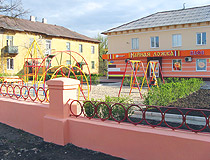
Cafe with a playground in Kramatorsk
Author: Vitaliy Rogozhinskiy
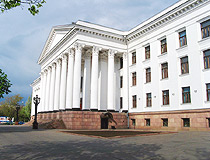
Palace of Culture and Technology in Kramatorsk
Author: Vitaliy Rogozhinskiy
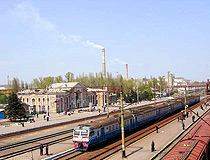
Kramatorsk Railway Station
Author: Vitaly Vigolov
Main Attractions of Kramatorsk
Kramatorsk Regional Landscape Park - an object of the natural reserve fund of Ukraine, created to preserve unique natural objects in 2014. The park is located around Kramatorsk and consists of five separate sections:
Bilen’ke (virgin steppe with numerous outcrops of chalk rocks), Bilokuz’mynivka (virgin forest steppe with a geological natural monument Rock outcrop of the Upper Cretaceous), Druzhkivs’ki Petrified Trees (petrified remains of coniferous trees over 200 million years old), Komyshuvakha (woodlands of oak, ash, maple, elm, and linden; a lake with swans and an abandoned estate of the 19th century known as the Bantyshev Estate), and Shabel’kivka (deciduous forests). Park employees conduct excursions throughout the entire territory or on separate natural objects of the park.
Palace of Culture and Technology of the Novokramatorsk Machine-Building Plant (1950-1965) - one of the architectural symbols of Kramatorsk, designed by architect D.M. Batalov. Inside there is a unique museum of this enterpise. The building is located on Myru Square in the very center of the city. The square was completely renovated in 2020. A large fountain was installed here with illumination at night.
Park “Yuvileynyy” - the main city park of Kramatorsk. In total, there are about 80 entertainment venues for sports and cultural purposes. In summer, several cafes are open here, there is a dance floor and a stage where concerts and discos are held. In 2021, an 80-meter flagpole with the largest state flag of Ukraine in Donetsk Oblast was installed here. Also on the territory of this park you can see the Holy Trinity Cathedral - the main Orthodox church of Kramatorsk built in 1996.
Fighter Aircraft MiG-17PF. This monument was opened on the territory of the Yuvileynyy park on September 8, 1973, in honor of the 30th anniversary of the liberation of Kramatorsk from German troops. Today, it is one of the most common meeting places for residents of the city. Intersection of Parkova and Yaroslava Mudroho streets.
Railway Locomotive 9P-337 - one of the newest monuments in Kramatorsk installed on the square near the Kramatorsk railway station in 2021. In addition to the fact that it looks very picturesque, it is special for Kramatorsk, since the city was founded as a railway station.
Bernatsky Garden. At the beginning of the 20th century, this park was run by the Kramatorsk plant. And among the people it remained as the “Garden of Bernatsky”, in honor of the last director of the plant. Here you can spend quite an exciting time, take a walk on the embankment and admire the view from unusual gazebos. Concerts of popular Ukrainian bands, football matches, sports and cultural events are often held here. Komarova Street, 2-15.
Museum of the History of Kramatorsk. In total, there are 7 halls in this museum devoted to the history of the development of Donbass and the city of Kramatorsk. Here you can also see an interesting collection of Ukrainian clothes and an exhibition in memory of the famous actor and director Leonid Bykov. The Kramatorsk Art Museum is located in the same building as well. Akademichna Street, 60.
Factory-Museum of Vintage Cars “Samokhod”. The collection of the museum has about 200 vintage cars (DKW, Horch, BMW, Steyr, Wanderer, Mercedes-Benz, Packard, Opel, Buick, etc.) and 80 motorcycles of the 1930s-1940s. Some of them belonged to famous people and witnessed important historical events. For example, a 1938 Buick Limited of the Soviet Marshal Georgy Zhukov, on which he traveled during the Second World War from Stalingrad to Berlin. Parkova Street, 74.


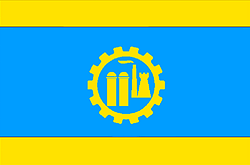




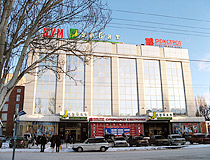
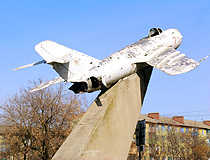
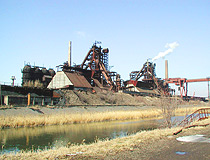
The comments of our visitors